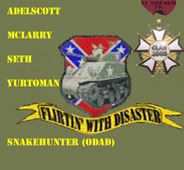Si puedes leer inglés te dejo un post que leí hace tiempo en
http://www.battlefront.com. Si no manejas la lengua de los bárbaros, estaré encantado de traducirlo esta tarde.
Los tantos por ciento expresan el grado de exposición de las fuerzas en cada terreno. Trench 9% implica por tanto que las tropas están protegidas en un 91%. Pozo de tirador en bosques o pinares, protección 89%-exposición 11%...
Espero que te sea de utilidad.
Type I cover. These are the strongest cover types, where dug in defenders should be.
trench - 9% exposure
heavy building - 10% exposure
foxhole in woods or pines - 11% exposure
woods or pines - 14% exposure
plus (special case)
heads down behind a stone wall - 0% exposure (infantry type fire has *no* effect, HE does)
Type II cover. These types are adequate for attackers to sit down in and conduct serious firefights. Defenders can use them for secondary positions. While not nearly as strong as type I, they have no cover panic effects and are close enough to type I for numbers to make up the difference.
foxholes in scattered trees - ~21% exposure
wooden buildings - 25% exposure
scattered trees - 25% exposure
rough - 25% exposure
heads up behind stone wall - 30% exposure
Type III cover, aka "approach cover". Suitable for moving attackers, to reduce incoming while closing the range. Attackers typically advance from patch to patch of this stuff, on their way to type I or II positions. You can firefight from it briefly in a pinch, but long firefights should not be attempted from it against enemies in Type I cover. Voids "cover panic" against weak fire only, strong fire (pinning, panicking strength) can set off "sideways sneaking".
foxholes - 44% exposure
shellholes - 44% exposure
brush - 50% exposure
wheat - 50% exposure
rocky - 50% exposure
cemetary - 50% exposure
Modest cover aides - these aren't a type proper, but are transitional between III and IV. For the most part they act like open ground, but they are marginally better than pure open. As such moving units sometimes need to rely on them, but they are not substitute for real cover. None of these will prevent "cover panic" from any fire beyond the "alerted" stage.
hedge - 60% exposure typically
fence - 60% typically
steppe - 65% typically, can hide at long range if stationary and not firing.
Type IV terrain, aka forms of open ground -
open - 70% exposed
pavement - 70% exposed
soft ground - 70% exposed and slowed movement
marsh - 65-70% exposed and very slow movement
Hazardous movement. Units shot in these are much more vunerable to large scale KIAs.
wire - 100% exposed and glacial movement
RR tracks - 100% exposed
bridge - 100% exposed
None of the exposure figures should be considered exact, because slight obstructions along the line of sight can lower the % exposed a few points. Deeper in trees can be 2-3% better than at the edge because of this, and the like.
There are also specific differences against HE types. % exposure governs the effect of infantry type fire (including MGs, vehicle MGs, etc).
any woods - mortars and indirect artillery more effective due to treebursts/airbursts. Especially true if not in a foxhole.
any building - flat trajectory HE is much more effective, because any round that physically strikes the building encounters reduced cover effects. Also, buildings in danger of collapse from damage will be abandoned.
trenches - very effective against off-map arty because few rounds will physically hit the small trench icon. On map HE, flat trajectory or mortars, that does hit the trench icon will be considerably more effective.
concealment terrain (e.g. brush, wheat) - most of the "cover" this provides is purely visual. HE pretty much ignores its effects. Against an MG, brush is almost as good as a shellhole - but against a mortar barrage the shellhole is far superior.
JasonC.
Edito porque acabo de aprender a sumar.
One lovely morning about the end of april 1913, found me very pleased with life in general...









